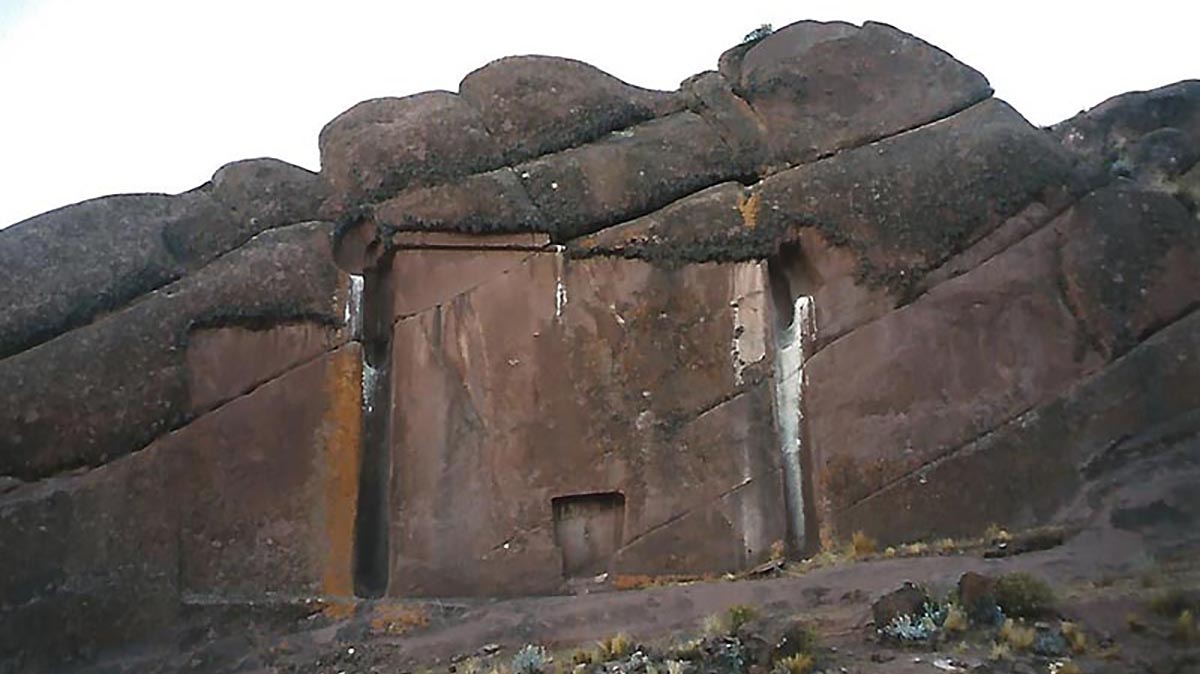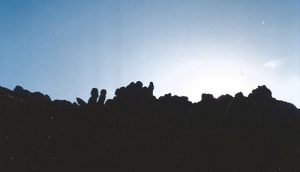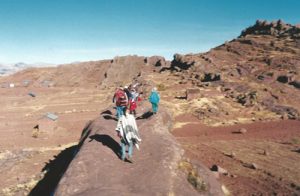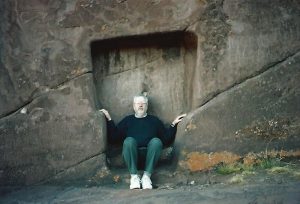
Aramu Muru Portal
Aramu Muru’s Portal was not on the itinerary of our “Sacred Mysteries of Peru” tour, so visiting it was an unexpected bonus. Most people have never heard of the portal, likely because it has only been known to tourists since 1992. The story of how I was taken to Aramu Muru’s Portal begins with two people, both of whose lives were shaped by the same influential book. The people are Mark Amaru Pinkham and Jorge Luis Delgado. The book is Secret of the Andes by Brother Philip.
First published in 1961, the book tells about the destruction of the great Pacific continent of Mu, which started before 30,000 bce. The last part of Mu to be submerged was Lemuria, lost between 10,000 and 12,000 bce, just before the sinking of Atlantis. One of the great sages or masters to escape from Lemuria was Lord Aramu Muru. He took scrolls containing great scientific and spiritual knowledge to a safe place in South America, where he established a Mystery School, the Monastery of the Seven Rays. He also brought a wonderful Solar Disc, which had been kept in the Temple of Divine Light in Lemuria. This disc, made of translucent, transmuted gold was a scientific instrument that could cause earthquakes or teleport people anywhere in the universe. The disc was first kept in an underground temple, but later it was moved to the Coricancha in Cuzco and used by the Incan High Priests. When Spanish conquerors invaded Peru, the disc was returned to the Monastery near Lake Titicaca.
The Monastery and its disc no longer exist in our dimension, but they “have been raised into the etheric realms. Some day they will be lowered again when man is spiritually ready to receive them,” according to Brother Philip. The author of Secret of the Andes is acknowledged to be George Hunt Williamson. Our research has revealed this was the pen name of Dr. Michael D. M. d’Obrenovic (1926-1986) an Eastern Orthodox bishop, anthropologist, archaeologist explorer and lecturer.
Mark Amaru Pinkham, one of the leaders of our tour, said Secret of the Andes had a very significant impact on his life. Mark’s search for the Monastery of the Seven Rays led him, through a variety of synchronicities, to meet Antón Ponce de León Paiva, a Peruvian who studied under the Andean Elders who maintain ancient secrets passed down from Aramu Muru. Antón is the author of The Wisdom of the Ancient ONE
and In Search of the Wise ONE, books that tell how he was taken blindfolded to a hidden village in the Andes and taught the true sacred history of all the Americas. Shirley Maclaine mentioned his encounters with ETs and UFOs in her book, Out on a Limb.
Antón is also an acquaintance of the other man who took me to Aramu Muru’s portal, Jorge Luis Delgado. The General Manager of Kontiki Tours and the owner of the Taypikela Hotel in Chucuito, near Puno, he had read Secret of the Andes and become interested in finding the Monastery of the Seven Rays about 19 years earlier. Jorge Luis told me that, before he found the portal he had been dreaming about pink stones, so he asked a shaman friend about them. Jorge Luis was told that there are many such places, but he should “follow the feeling, follow the energy.” He kept looking, and finally one a place near Lake Titicaca felt familiar to Jorge Luis. It had two stone formations with holes in them, and it was facing the sunrise. He found formations shaped like a snake, a puma and a condor, and they led him to the portal.
“When I took Anton Ponce de Leon Paiva to the Aramu Muru Portal,” Jorge Luis said, “the clouds overhead were beautiful, like rainbows, always changing colors. Anton took very many pictures, and none of them came out.” Jorge Luis shrugged philosophically. When you’re dealing with non-ordinary happenings, you can’t expect them always to show up on film.
I had a similar problem. Both of my cameras had fallen apart at Machu Picchu a few days earlier. Was this a coincidence, the effects of a high-energy environment or a sign that I should spend less time experiencing these places through a viewfinder? The photographs accompanying this article were taken by my wife Mary and two of the others in our group. Fortunately, their cameras survived the trip unscathed.
On the day-long bus trip from Cuzco to Puno, Mark had told us dozens of fascinating stories about Lake Titicaca. It is a powerful inter-dimensional vortex, and UFOs are frequently sighted in the area. Some people believe the Sun Disk of Amaru Muru is at the bottom of the lake, but it may be accessible from the inter-dimensional gateway, Amaru Muru’s Portal.
 All over the area are rock formations shaped like various creatures, human and animal. The stones are so weathered it’s hard to tell whether they were carved deliberately or shaped by wind and rain. Jorge Luis believes the area was built by one of the earliest Peruvian civilizations, with the help of extraterrestrials, probably about the same time as Marca Huasi was created, more than 10,000 years ago. Mark Amaru Pinkham also felt that this was the site of an ancient mystery school.
All over the area are rock formations shaped like various creatures, human and animal. The stones are so weathered it’s hard to tell whether they were carved deliberately or shaped by wind and rain. Jorge Luis believes the area was built by one of the earliest Peruvian civilizations, with the help of extraterrestrials, probably about the same time as Marca Huasi was created, more than 10,000 years ago. Mark Amaru Pinkham also felt that this was the site of an ancient mystery school.
 “All the legends have evidence here,” Jorge Luis told our group. He pointed out one rock formation, about twenty feet long, that looked like a caterpillar. He told us that it is a larva, and it illustrates one of the ancient legends: Once there were many larvae living in the underworld. They heard of a place called Ruma, where there was everything you could wish for, including power and wisdom. All the larvae wanted to go to this place, and one of them left the underworld to look for it. When he got outside he found a mountain of dead larvae who had been fighting each other to get to the top. Discouraged, he went back home, only to discover all his friends were gone. He had the feeling someone was watching him. Finally, a butterfly appeared and spoke to him. It was the girlfriend he had left behind, and while he was away she metamorphosed into a butterfly. She told him, “You went to the wrong place to find what you were looking for.” To the west, on a hilltop looking down at the larva, is a rock formation shaped like a butterfly.
“All the legends have evidence here,” Jorge Luis told our group. He pointed out one rock formation, about twenty feet long, that looked like a caterpillar. He told us that it is a larva, and it illustrates one of the ancient legends: Once there were many larvae living in the underworld. They heard of a place called Ruma, where there was everything you could wish for, including power and wisdom. All the larvae wanted to go to this place, and one of them left the underworld to look for it. When he got outside he found a mountain of dead larvae who had been fighting each other to get to the top. Discouraged, he went back home, only to discover all his friends were gone. He had the feeling someone was watching him. Finally, a butterfly appeared and spoke to him. It was the girlfriend he had left behind, and while he was away she metamorphosed into a butterfly. She told him, “You went to the wrong place to find what you were looking for.” To the west, on a hilltop looking down at the larva, is a rock formation shaped like a butterfly.
 We walked for fifteen or twenty minutes, at a relatively slow pace, before we reached Amaru Muru’s portal. Five or six native children had been walking with us. Actually, they were surprisingly annoying. Many of the Peruvian youngsters we encountered asked us for hand-outs or tried to sell us things, but these obnoxious kids wouldn’t stop pestering us. My standard, polite “No, gracias” had turned into a gruff “NO!”, and still they dogged my heels. It wasn’t just me. Even the most generous people in our group, who ordinarily were patient and loving to local children, were getting agitated by the little beggars. It wasn’t until we neared the portal that I suddenly realized the kids were gone.
We walked for fifteen or twenty minutes, at a relatively slow pace, before we reached Amaru Muru’s portal. Five or six native children had been walking with us. Actually, they were surprisingly annoying. Many of the Peruvian youngsters we encountered asked us for hand-outs or tried to sell us things, but these obnoxious kids wouldn’t stop pestering us. My standard, polite “No, gracias” had turned into a gruff “NO!”, and still they dogged my heels. It wasn’t just me. Even the most generous people in our group, who ordinarily were patient and loving to local children, were getting agitated by the little beggars. It wasn’t until we neared the portal that I suddenly realized the kids were gone.
The area immediately west of the portal is known as the House of the Spirits. “Shamans come here to communicate with the spirits,” Jorge Luis told us. I stood near the edge of a steep drop-off between two rock walls. The sun was going down but a few bright patches of sunlight dotted the valley below. A strong, cold wind blew out from among the strange rock formations. Jorge Luis said there was a very old stone that looked like an old condor, but we did not want to stop and look for it. The sun was sinking and we were eager to get to the doorway. Still, the power of the place was tangible. I had no doubt that shamans did communicate with spirits here.
The doorway is carved into a stone wall that faces east, toward Lake Titicaca, the Island of the Sun and the distant, sacred snow-capped Apus. Flanking the doorway are two vertical channels, about twenty feet tall, carved into the rock. These look very similar to the well-known serpent carving at Sacsayhuaman, where seven scallops cut into a huge stone are the same size and shape as a human spine and head. It is believed that seven crystal spheres, representing the seven chakras, were once set into the rock at Sacsayhuaman. The serpent-shaped channels on either side of Aramu Muru’s Portal are wide enough to accommodate a person easily. I walked up to one, backed in and looked up toward the sky. As the back of my head touched the cold stone I was dazzled by the sight of the first-quarter moon directly over the top of my “tube.” I felt like the power of the moon was channeling right down and into me.
The Portal itself is barely six feet tall. Notches on each side are perfectly aligned rests for your hands whether you choose to sit facing east or kneel toward the west. “The key to the portal is the human body,” Jorge Luis said. “It is more open now and it feels more powerful than in 1992 when we received permission to start taking pilgrims to the gate.” Was it a coincidence that year marked the 500th anniversary of Columbus’ famous voyage?
 There were eleven in our group: Mark and his wife Andrea, Jorge Louis, and Mary and me, and six other gringo tourists. We took turns sitting or kneeling in the doorway, standing in the side channels, taking pictures in the fading light or just sitting on the ground dazed and amazed. Mary was surprised to see that we were being watched. She pointed out to me that a group of fifteen or so Quechua adults had gathered about 100 feet away from the doorway where we were. Unlike everywhere else we visited in Peru, they didn’t approach us, nor try to sell us anything nor beg money from us. Instead they watched us in silence, barely even talking among themselves. Maybe they were simply being respectful, as we appeared to be performing serious, religious-type rituals at the doorway. Or maybe they were afraid to come too close to the doorway itself.
There were eleven in our group: Mark and his wife Andrea, Jorge Louis, and Mary and me, and six other gringo tourists. We took turns sitting or kneeling in the doorway, standing in the side channels, taking pictures in the fading light or just sitting on the ground dazed and amazed. Mary was surprised to see that we were being watched. She pointed out to me that a group of fifteen or so Quechua adults had gathered about 100 feet away from the doorway where we were. Unlike everywhere else we visited in Peru, they didn’t approach us, nor try to sell us anything nor beg money from us. Instead they watched us in silence, barely even talking among themselves. Maybe they were simply being respectful, as we appeared to be performing serious, religious-type rituals at the doorway. Or maybe they were afraid to come too close to the doorway itself.
None of us succeeded in moving into the other dimension and finding Aramu Muru’s golden solar disk, but each of us agreed that this was the most powerful place of the entire trip. I sat in the doorway and, for the briefest instant, I seemed to “see” a greenish flash that seemed like a tunnel. Nearly all of us had a different experience. Some sensed sounds or colors. One felt a part of something very, very old.
Of all the places I visited in Peru, this is the one I most eagerly want to return to. I especially want to experience it at sunrise, when the sun would rise over Lake Titicaca and the Island of the Sun and fall directly onto the portal.
It was nearly dark by the time we left, and I’m glad we didn’t stay any longer. We were told of several strange occurrences that happened here. A group of musicians who used to live in the region disappeared. It is said they disappeared through the gate, and that sometimes you can hear music coming up through the stone. Local people are afraid to come here at night. They say the doorway calls people and they disappear. We certainly saw that even the boisterous local children seemed to have a healthy respect for the doorway in the daytime!
Our private bus was waiting for us a short distance from the portal, farther south along the highway from where it had dropped us off. As we rode back toward Chucuito, I was amazed at how much graffiti there was. Political slogans were splashed in white paint all over the red rock walls that faced the highway. Obviously there were locals who either didn’t know or didn’t care that they were vandalizing the edges of a powerful, sacred place. Is it their attitude that must change before the blessings of Aramu Muru’s golden disc will once again emerge from its hiding place?
Many times in Peru we were told that a significant change is coming soon. At Machu Picchu the shaman, Kucho, said “big changes will happen to the world in the next few years.” In Pisac Andrea Mikana Pinkham, channeling the Kumaras, revealed that a major upheaval in our planet will occur within five to ten years. One hopes these changes are positive ones, brought about by humans having become spiritually ready to receive the gifts of enlightenment, including the golden Sun Disk of Aramu Muru.
This article was originally published in the February, 1999 issue of Power Trips magazine. The Lake Titicaca region is one of the areas I described as Earth’s Three Most Powerful Places.
Browse Aramu Muru Portal Tours Now Available